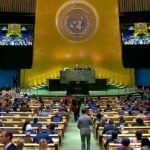Leningrad siege survivor Lyudmila Vasilyeva staged a rare anti-war protest in St. Petersburg on the third anniversary of Russia’s full-scale invasion of Ukraine, the local news outlet Bumaga reported Monday.
The 83-year-old Vasilyeva stood outside the Gostiny Dvor shopping center in central St. Petersburg holding a sign that read: “People, let’s stop the war! We’re responsible for peace on planet Earth.”
Police attempted to detain Vasilyeva 10 minutes into her protest, but she told Bumaga that she refused to leave without a lawyer.
“They asked me who ordered me to come, but you can tell that no one sent me,” she told the news outlet.
Despite police pressure, Vasilyeva continued her protest for an hour without being detained. She said at least five officers attempted to persuade her to stop.
“I told them they follow criminal orders and that they’re also responsible for this war,” she said, claiming some officers privately agreed with her.
Vasilyeva was briefly detained at least three times for protesting in the early days of Russia’s full-scale invasion in 2022. She unsuccessfully ran for the office of St. Petersburg governor last year.
In Moscow, residents marked the war’s anniversary on Monday by laying flowers and written messages at the base of a statue of Ukrainian poet Lesya Ukrainka.
Anti-war protests have been criminalized in Russia, with activists jailed, forced underground or driven into exile.
A Message from The Moscow Times:
Dear readers,
We are facing unprecedented challenges. Russia’s Prosecutor General’s Office has designated The Moscow Times as an “undesirable” organization, criminalizing our work and putting our staff at risk of prosecution. This follows our earlier unjust labeling as a “foreign agent.”
These actions are direct attempts to silence independent journalism in Russia. The authorities claim our work “discredits the decisions of the Russian leadership.” We see things differently: we strive to provide accurate, unbiased reporting on Russia.
We, the journalists of The Moscow Times, refuse to be silenced. But to continue our work, we need your help.
Your support, no matter how small, makes a world of difference. If you can, please support us monthly starting from just $2. It’s quick to set up, and every contribution makes a significant impact.
By supporting The Moscow Times, you’re defending open, independent journalism in the face of repression. Thank you for standing with us.
Continue
Not ready to support today?
Remind me later.
×
Remind me next month
Thank you! Your reminder is set.
















